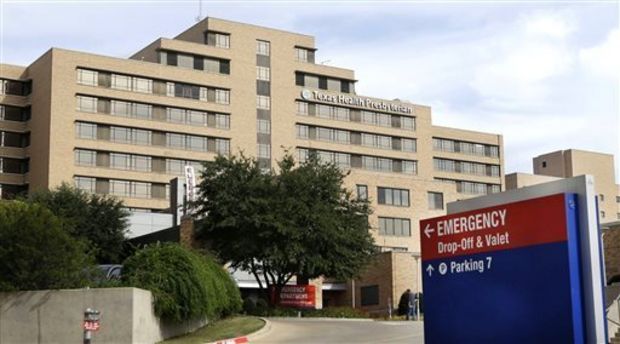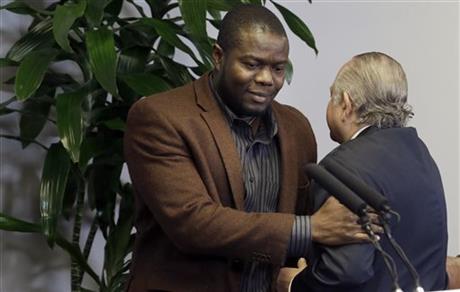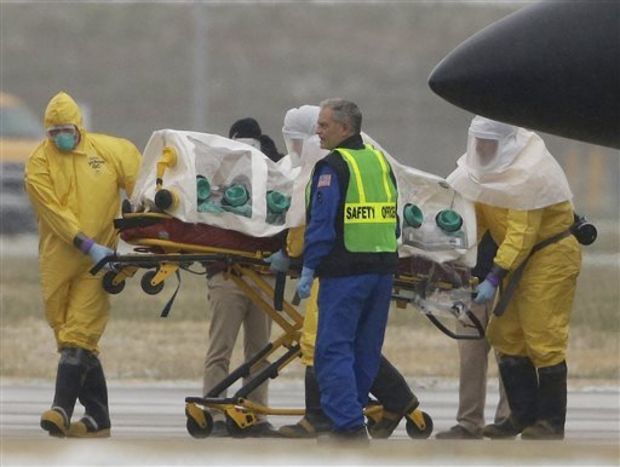

DALLAS (AP) — A Texas health care worker who was in full protective gear when they provided hospital care for an Ebola patient who later died has tested positive for the virus and is in stable condition, health officials said Sunday.
If the preliminary diagnosis is confirmed by the Disease Control and Prevention in Atlanta, it would be the first known case of the disease being contracted or transmitted in the U.S.
Dr. Daniel Varga, of the Texas Health Resource, said during a news conference Sunday that the worker wore a gown, gloves, mask and shield when they provided care to Thomas Eric Duncan during his second visit to Texas Health Presbyterian Hospital. Varga did not identify the worker and says the family of the worker has “requested total privacy.”
Varga says the health care worker reported a fever Friday night as part of a self-monitoring regimen required by the Atlanta-based Center for Disease Control.
Duncan, the first person diagnosed with Ebola in the U.S., died Wednesday in Dallas.
“We knew a second case could be a reality, and we’ve been preparing for this possibility,” Dr. David Lakey, commissioner of the Texas Department of State Health Services, said in a statement Sunday. “We are broadening our team in Dallas and working with extreme diligence to prevent further spread.”
Health officials have interviewed the patient and are identifying any contacts or potential exposures. They said people who had contact with the health care worker after symptoms emerged will be monitored based on the nature of their interactions and the potential they were exposed to the virus.
More than 4,000 people have died in the ongoing Ebola epidemic centered in West Africa, according to World Health Organization figures published Friday. Almost all of those deaths have been in the three worst-affected countries, Liberia, Sierra Leone and Guinea.
Ebola spreads through close contact with a symptomatic person’s bodily fluids, such as blood, sweat, vomit, feces, urine, saliva or semen. Those fluids must have an entry point, like a cut or scrape or someone touching the nose, mouth or eyes with contaminated hands, or being splashed. The World Health Organization says blood, feces and vomit are the most infectious fluids, while the virus is found in saliva mostly once patients are severely ill and the whole live virus has never been culled from sweat.
Thomas Eric Duncan, the first person diagnosed with Ebola in the U.S., died Wednesday in Dallas. Duncan, 42, grew up next to a leper colony in Liberia and fled years of war before later returning to his country to find it ravaged by the disease that ultimately took his life.
Duncan arrived in Dallas in late September, realizing a long-held ambition to join relatives. He came to attend the high-school graduation of his son, who was born in a refugee camp in Ivory Coast and was brought to the U.S. as a toddler when the boy’s mother successfully applied for resettlement.
The trip was the culmination of decades of effort, friends and family members said. But when Duncan arrived in Dallas, though he showed no symptoms, he had already been exposed to Ebola. His neighbors in Liberia believe Duncan become infected when he helped a pregnant neighbor who later died from it. It was unclear if he knew about her diagnosis before traveling.
Duncan had arrived at a friend’s Dallas apartment on Sept. 20 — less than a week after helping his sick neighbor. For the nine days before he was taken to a hospital in an ambulance, Duncan shared the apartment with several people.
Ebola: How it spreads
Here are some facts about how Ebola spreads:
WHEN IS EBOLA CONTAGIOUS?
Only when someone is showing symptoms, which can start with vague symptoms including a fever, flu-like body aches and abdominal pain, and then vomiting and diarrhea.
HOW DOES EBOLA SPREAD?
Through close contact with a symptomatic person’s bodily fluids, such as blood, sweat, vomit, feces, urine, saliva or semen. Those fluids must have an entry point, like a cut or scrape or someone touching the nose, mouth or eyes with contaminated hands, or being splashed. That’s why health care workers wear protective gloves and other equipment.
The World Health Organization says blood, feces and vomit are the most infectious fluids, while the virus is found in saliva mostly once patients are severely ill and the whole live virus has never been culled from sweat.
The Texas Department of State Health Services said Sunday that a health-care worker who provided hospital care for the first patient to die from Ebola in the United States has tested positive for the virus. The worker was not identified and it was unclear what level of care the worker provided or when the health worker came into contact with the patient. If the diagnosis is confirmed, it would be the first known case of Ebola being transmitted in the U.S.
WHAT ABOUT MORE CASUAL CONTACT?
Ebola isn’t airborne. Dr. Tom Frieden, director of the Centers for Disease Control and Prevention, has said people don’t get exposed by sitting next to someone on the bus.
“This is not like flu. It’s not like measles, not like the common cold. It’s not as spreadable, it’s not as infectious as those conditions,” he added.
WHO GETS TESTED WHEN EBOLA IS SUSPECTED?
Hospitals with a suspected case call their health department or the CDC to go through a checklist to determine the person’s level of risk. Among the questions are whether the person reports a risky contact with a known Ebola patient, how sick they are and whether an alternative diagnosis is more likely. Most initially suspicious cases in the U.S. haven’t met the criteria for testing.
HOW IS IT CLEANED UP?
The CDC says bleach and other hospital disinfectants kill Ebola. Dried virus on surfaces survives only for several hours.



